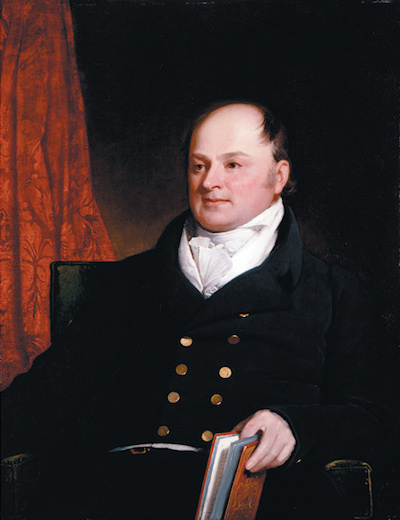The Son of a Founding Father
John Quincy Adams was born on July 11, 1767, to Abigail and John Adams in Braintree, Massachusetts. John Quincy was largely raised by his mother because his father was heavily involved in the American Revolution. The older Adams would participate in the First Continental Congress, help draft the Declaration of Independence, and oversee the Revolutionary War, keeping him from playing a major role in his son's life. Early on in the Revolutionary War, John Quincy Adams feared his family would be kidnapped or killed because his father signed the Declaration of Independence. John Quincy witnessed the war firsthand as his hometown was so close to the center of Revolutionary action. Soldiers often marched right through his yard. From the ages of ten to seventeen, John Quincy accompanied his father on a special convoy to Europe, where he spent seven years traveling to Prussia, the Netherlands, England, and even Paris, where he went to school with the grandsons of Benjamin Franklin. John Quincy spent many years in Europe with and without his father, and was even asked to serve as a translator for an American emissary in St. Petersburg, Russia. John Quincy returned to the United States in 1785 and enrolled in Harvard as an advanced student, graduating in just two years with a law degree. After graduation, John Quincy opened his own law firm in Massachusetts but quickly eschewed law for a career in politics.
Involved in Domestic and International Politics
John Quincy admired Thomas Jefferson, the writer of the Declaration of Independence, and was a major supporter of the George Washington administration after his father was selected as vice president. Washington appreciated the support of John Quincy so much that he chose him to travel to the Netherlands to negotiate the repayment of Dutch loans to America. After John Quincy's father was elected president in 1796, he sent John Quincy to be the minister to Prussia. When Adams lost his bid for reelection to Thomas Jefferson in 1800, Jefferson recalled John Quincy, bringing him back to the United States. After he came back to the States, John Quincy began practicing law again in Boston in 1801, but the next year he was elected to the Massachusetts State Senate and then the US Senate. While in the Senate, John Quincy was turned off by the partisan politics of the time. He was ostracized by the Federalist Party for his anti-Federalist voting, prompting him to resign from the Senate and return to Harvard, where he became a professor.
Architect of the Monroe Doctrine
When James Monroe became president in 1817, he appointed John Ambassador to the Russian Court. His stint as ambassador to Russia was temporary as he was called to Belgium to negotiate the Treaty of Ghent, which was the peace treaty that ended the War of 1812. John Quincy was then named Secretary of State in the Monroe cabinet and was the architect behind the Monroe Doctrine, which aimed to prevent European colonization in Latin America by affirming that the United States would provide protection over the entire Western Hemisphere. The Monroe Doctrine was America's first articulation of foreign policy. Together with James Monroe and other American politicians of the time, Adams helped to usher in a period of American history known as the Era of Good Feeling.
 |
| John Quincy Adams as Secretary of State |
The Sixth President and the Corrupt Bargain
In 1824, John Quincy Adams won one of the most controversial presidential elections in American history, becoming the nation's sixth president. In the election, neither Adams nor Andrew Jackson received the majority of electoral votes, leaving it to Congress to determine the victor. In what came to be known as the "corrupt bargain," it is believed that John Quincy offered Senator Henry Clay the Secretary of State position if he convinced Congress to elect him president instead of his opponent, Andrew Jackson. The corrupt bargain angered many Jackson supporters and even caused Jackson to resign from the Senate.
The Ups and Downs of the Presidency
John Quincy's term as president was marred by controversy created by his political enemies (Jackson supporters), who aimed to block any new legislation he supported. During his presidency, industrialization intensified in the Northern United States, highlighted by construction of the Erie Canal. Adams was also successful in paying off much of the national debt.
Abolitionist
In 1828, John Quincy ran for reelection against Andrew Jackson but was defeated, becoming only the second president to fail in a reelection bid (the first was his father). After the loss to Jackson, John Quincy returned home to Massachusetts, where he served in the House fighting for the abolition of slavery. John Quincy Adams died in 1848.